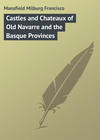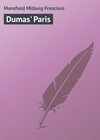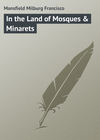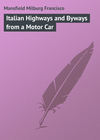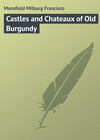Czytaj książkę: «The Automobilist Abroad», strona 10
Chapter VI
The Road To The North
We left Paris by the ghastly route leading out through the plain of Gennevilliers, where Paris empties her sewage and grows asparagus, passing St. Denis and its royal catacombs of the ancient abbey, and so on to Pontoise, all over as vile a stretch of road as one will find in the north of France, always excepting the suburbs of St. Germain.
Pontoise is all very well in its way, and is by no means a dull, uninteresting town, but we had no thoughts for it at the moment; indeed, we had no thoughts of anything but to put the horrible suburban Paris pavé as far behind us as we could before we settled down to enjoyment.
At Pontoise we suddenly discovered that we were on the wrong road. So much for not knowing our way out of town – twenty-five kilometres of axle-breaking cobblestones!
We had some consolation in knowing that it was equally as bad by any northern road out of Paris, so we only had the trouble of making a twenty-kilometre detour through the valley of the Oise, by our old haunts of Auvers and L'Isle-Adam to Chantilly and Senlis.
We got our clue to the itinerary of the road to the north from a view of an old poster issued by the "Messageries Royales" just previous to the Revolution (a copy of which is given elsewhere in this book).
Many were the times we, and all well-habituated travellers in France, had swung from Calais to Paris by train, with little thought indeed as to what lay between. True, we had, more than once, "stopped off" at Amiens and Abbeville to see their magnificent churches, and we had spent a long summer at Etaples and Montreuil-sur-Mer, two "artists' haunts" but little known to the general traveller; but we never really knew the lay of the land north of Paris, except as we had got it from the reading of Dumas, Stevenson's "Inland Voyage," and the sentimental journeyings of the always delightful Sterne.
We made Chantilly our stop for lunch, en route to Senlis. We ought not to have done this, for what with the loafing horse-jockeys in the cafés, and the trainers and "cheap sports" hanging about the hotels, Chantilly does not impress one as the historical shrine that it really is.
Chantilly is sporty, très sportive, as the French call it, as is inevitable of France's most popular race-track, and there is an odour of America, Ireland, and England over all. How many jockeys of these nationalities one really finds at Chantilly the writer does not know, but, judging from the alacrity with which the hotels serve you ham and eggs and the café waiters respond to a demand for whiskey (Scotch, Irish, or American), it may be assumed that the alien population is very large.
We had our lunch at the Hôtel du Grand Condé, which is marked with three stars in the automobile route-books. This means that it is expensive, – and so we found it. It was a good enough hotel of its kind, but there was nothing of local colour about it. It might have been at Paris, Biarritz, or Monte Carlo.
The great attractions of Chantilly are the château and park and the collections of the Duc d'Aumale, famed alike in the annals of history and art. We were properly appreciative, and only barely escaped being carried off by our guide to see the stables – as if we had not suffered enough from the horse craze ever since we had struck the town.
The most we would do was to admire the park and the ramifications of its paths and alleys which dwindled imperceptibly into the great Forêt de Chantilly itself. The forest is one of those vast tracts of wildwood which are so plentifully besprinkled all over France. Their equals are not known elsewhere, for they are crossed and recrossed in all directions by well-kept carriage roads where automobilists will be troubled neither by dust nor glaring sunlight. They are the very ideals of roads, the forest roads of France, and their length is many thousands of kilometres.
Senlis is but eight kilometres from Chantilly. We had no reason for going there at all, except to have a look at its little-known, but very beautiful, cathedral, and to get on the real road to the north.
We spent the night at Senlis, for we had become fatigued with the horrible pavé of the early morning, the sightseeing of the tourist order which we had done at Chantilly, and the eternal dodging of race-horses being exercised all through the streets of the town and the roads of the forest.
"Monsieur descend-il à l'Hôtel du Grand Monarque?" asked a butcher's boy of us, as we stopped the automobile beneath the cathedral tower to get our bearings. He was probably looking for a little commission on our hotel-bill for showing us the way; but, after all, this is a legitimate enough proposition. We told him frankly no; that we were looking for the Hôtel des Arènes; but that he knew nothing of. Another, more enterprising, did, and we drove our automobile into the court of a tiny little commercial-looking hotel, and were soon strolling about the town free from further care for the day. The hotel was ordinary enough, neither good nor bad, comme 'ci, comme ça, the French would call it, – but they made no objection to getting up at six o'clock the next morning and making us fresh coffee which was a dream of excellence. This is a good deal in its favour, for the coffee of the ordinary French country hotel – in the north, in particular – is fearfully and wonderfully made, principally of chicory.
Sentiment would be served, and from Senlis we struck across forty kilometres to what may be called the Dumas Country, Crépy-en-Valois and Villers-Cotterets. Here was a little-trodden haunt which all lovers of romance and history would naturally fall in love with.
Crépy is a snug, conservative little town where life goes on in much the same way that it did in the days when Alexandre Dumas was a clerk here in a notary's office, before he descended upon the Parisian world of letters. His "Mémoires" tell the story of his early experiences here in his beloved Valois country. It is a charming biographical work, Dumas's "Mémoires," and it is a pity it is not better known to English readers. Dumas tells of his journey by road, from the town of his birth, Villers-Cotterets, to Crépy, with his world's belongings done up in a handkerchief on a stick, "in bulk not more grand than the luggage of a Savoyard when he leaves his native mountain home."
Crépy has a delightfully named and equally excellent hotel in the "Trois Pigeons," and one may eat of real country fare and be happy and forget all about the ham and eggs and bad whiskey of Chantilly in the contemplation of omelettes and chickens and fresh, green salads, such as only the country innkeeper in France knows how to serve. Crépy has a château, too, a relic of the days when the town was the capital of a petit gouvernement belonging to a younger branch of the royal family of France in the fourteenth century. The château is not quite one's ideal of what a great mediæval château should be, but it is sufficiently imposing to give a distinction to the landscape and is in every way a very representative example of the construction of the time.
The great Route Nationale to the north runs through Crépy to-day, as did the Route Royale of the days of the Valois. It is eighteen kilometres from Crépy to Villers-Cotterets, Dumas's birthplace. The great romancer describes it with much charm and correctness in the early pages of "The Taking of the Bastile." He calls it "a little city buried in the shade of a vast park planted by François I. and Henri II." It is a place ever associated with romance and history, and, to add further to its reputation, it is but a few kilometres away from La Ferte-Milon, where Racine was born, and only eight leagues from Château-Thierry, the birthplace of La Fontaine.
We had made up our minds to breathe as much of the spirit and atmosphere of Villers-Cotterets as was possible in a short time, and accordingly we settled down for the night at the Hôtel Alexandre Dumas. The name of the hotel is unusual. There may be others similar, but the writer does not recall them at this moment. It was not bad, and, though entitled to be called a grand establishment, it was not given to pomposity or pretence, and we parted with regret, for we had been treated most genially by the proprietor and his wife, and served by a charming young maid, who, we learned, was the daughter of the house. It was all in the family, and because of that everything was excellently done.
There are fragments of a royal château here, begun by François I. in one of his building manias. His salamanders and the three crescents of Diane de Poitiers still decorate its walls, and accordingly it is a historical shrine of the first rank, though descended in these later days to use as a poorhouse.
The château and forest of Villers-Cotterets were settled upon Monsieur le Grand by Louis XIV., after they had sheltered many previous royal loves, but in the days of the later monarchy, that of Philippe Egalité, the place was used merely as a hunting rendezvous.
The Dumas birthplace is an ordinary enough and dismal-looking building from the street. As usual in France, there is another structure in the rear, the real birthplace, no doubt, but one gets only a glimpse through the open door or gate. Carrier-Belleus's fine statue of Dumas, erected here in 1885, is all that a monument of its class should be, and is the pride of the local inhabitant, who, when passing, never tires of stopping and gazing at its outlines. This may be a little exaggeration, but there is a remarkable amount of veneration bestowed upon it by all dwellers in the town.
We went from Villers-Cotterets direct to Soissons, the home of the beans of that name. We do not know these medium-sized flat beans as soissons in America and England; to us they are merely beans; but to soissons they are known all over France, and in the mind and taste of the epicure there is no other bean just like them. This may be so or not, but there is no possible doubt whatever but that "soissons au beurre" is a ravishing dish which one meets with too infrequently, even in France, and this in spite of the millions of kilos of them which reach the markets through the gateway of the town of Soissons.
Soissons undoubtedly has a good hotel. How could it be otherwise in such a food-producing centre? We were directed, however, by a commis-voyageur whom we had met at Villers-Cotterets, not to think of a hotel at Soissons, if we were only to stop for lunch, but to go to the railway restaurant. Of all things this would be the most strange for an automobilist, but we took his advice, for he said he knew what he was talking about.
The "Buffet" at the railway station at Soissons is not the only example of a good railway eating-house in France, but truly it is one of the best. It is a marvellously conducted establishment, and you eat your meals in a beautifully designed, well-kept apartment, with the viands of the country of the best and of great variety. Soissons au beurre was the pièce de résistance, and there was poulet au casserole, an omelette au rhum, a crisp, cold lettuce salad, and fruits and "biscuits" galore to top off, with wine and bread à discrétion and good coffee and cognac for ten sous additional, the whole totalling three francs fifty centimes. We were probably the first automobilists on tour who had taken lunch at the railway restaurant at Soissons. Perhaps we may not be the last.
It was but a short detour of a dozen or fifteen kilometres to visit the romantic Château de Coucy, one of the few relics of mediævalism which still look warlike. It is more or less of a ruin, but it has been restored in part, and, taken all in all, is the most formidable thing of its kind in existence. It rises above the old walled town of Coucy-le-Château in quite the fashion that one expects, and, from the platform of the donjon, there spreads out a wonderful view over two deep and smiling valleys which, as much as the thickness of the château walls, effectually protected the occupants from a surprise attack.
The thirteenth century saw the birth of this, perhaps the finest example still remaining of France's feudal châteaux, and, barring the effects of an earthquake in 1692, and an attempt by Richelieu to blow it up, the symmetrical outlines of its walls and roofs are much as they always were.
Its founder was Enguerrand III. de Coucy, who took for his motto these boastful words – which, however, he and his descendants justified whenever occasion offered:
"Roi je ne suis,
Prince, ni Comte aussi,
Je suis le Sire de Coucy."
We left Coucy rejoicing, happy and content, expecting to reach Laon that night. We had double-starred Laon in our itinerary, because it was one of those neglected tourist-points that we always made a point of visiting when in the neighbourhood.
Laon possesses one of the most remarkable cathedrals of Northern France, but its hotels are bad. We tried two and regretted we ever came, except for the opportunity of marvelling at the commanding site of the town and its cathedral. The long zigzag road winding up the hill offers little inducement to one to run his automobile up to the plateau upon which sits the town proper. It were wiser not to attempt to negotiate it if there were any way to avoid it. We solved the problem by putting up at a little hotel opposite the railway station (its name is a blank, being utterly forgotten) where the commis-voyageur goes when he wants a meal while waiting for the next train. He seems to like it, and you do certainly get a good dinner, but, not being commis-voyageurs, merely automobilists, we were charged three prices for everything, and accordingly every one is advised to risk the dangerous and precipitous road to the upper town rather than be blackmailed in this way.
Laon's cathedral, had it ever been carried out according to the original plans, would have been the most stupendously imposing ecclesiastical monument in Northern France. Possibly the task was too great for accomplishment, for its stones and timbers were laboriously carried up the same zigzag that one sees to-day, and it never grew beyond its present half-finished condition. The year 1200 probably saw its commencement, and it is as thoroughly representative of the transition from Romanesque to Gothic as any other existing example of church building.
On the great massive towers of Laon's cathedral is to be seen a most curious and unchurchly symbolism in the shape of great stone effigies of oxen, pointing north, east, south, and west. There is no religious significance, we are told, but they are a tribute to the faithful services of the oxen who drew the heavy loads of building material from the plain to the hilltop.
We had taken a roundabout road to the north, via Laon, merely to see the oxen of the cathedral and to get swindled for our lunch at that unspeakable little hotel. The one was worth the time and trouble, the other was not. We left town the same night headed north, in the direction of Arras, via St. Quentin, anciently one of the famous walled towns of France, but now a queer, if picturesque, conglomeration of relics of a historical past and modern business affairs.
It was Sunday, and well into the afternoon, when we got away from Laon, but the peasant, profiting by the fair harvest days, was working in the fields as if he never had or would have a holiday. Unquestionably the peasant and labouring class in France is hard-working at his daily task and at his play, for when he plays he also plays hard. This, the eternal activity of the peasant or labourer, whatever his trade, and the worked-over little farm-holdings, with their varied crops, all planted in little bedquilt patches, are the chief characteristics of the French countryside for the observant stranger.
We crossed the Oise at La Fere, La Fere of wicked memory, as readers of Stevenson will recall. Nothing went very badly with us, but all the same the memory of Stevenson's misadventure at his hotel made us glad we were not stopping there.
We passed now innumerable little towns and villages clinging to red, brown, and green hillsides, with here and there a thatched cottage of other days, for, in the agglomérations, as the French government knows the hamlets and towns, it is now forbidden to thatch or rethatch a roof; you must renew it with tiles or slates when the original thatch wears out.
Soon after passing La Fere one sees three hilltop forts, for we are now in more or less strategic ground, and militarism is rampant.
St. Quentin has been the very centre of a warlike maelstrom for ages, and the memory of blood and fire lies over all its history, though to-day, as we entered its encumbered, crooked streets, things looked far from warlike.
We had our choice of the Hôtel du Cygne or the Hôtel du Commerce at St. Quentin, and chose the latter as being nearer the soil, whereas the former establishment is blessed with electric lights, a calorifère, and a "bar" – importing the word and the institution from England or America.
We found nothing remarkable in the catering of the Hôtel du Commerce. It was good enough of its kind, but not distinctive, and we got beer served with our dinner, instead of wine or cider. If you want either of the latter you must pay extra. We were in the beer region, not the cider country or the wine belt. It was the custom, and was not being "sprung" on us because we were automobilists. This we were glad to know after our experience at Laon.
St. Quentin possesses a famous Gothic church, known to all students of Continental architecture, and there is a monument of the siege of 1557, which is counted another "sight," though strictly a modern work.
At St. Quentin one remarks the Canal de St. Quentin, another of those inland waterways of France which are the marvel of the stranger and the profit of the inhabitant. This particular canal connects France with the extraterritorial commerce of the Pays Bas, and runs from the Somme to the Scheldt, burrowing through hillsides with tunnels, and bridging gaps and valleys with viaducts. One of these canal-tunnels, at Riqueval, has a length of nearly four miles.
We worried our way out through the crooked streets of St. Quentin at an early hour the next morning, en route for Arras, via Cambrai. Forty-two kilometres of "ond. dure.," but otherwise excellent roadway, brought us to Cambrai. (For those who do not read readily the French route-book directions the above expression is translated as "rolling and difficult.")
It matters little whether the roadways of France are marked rolling and serpentine, or hilly and winding, the surfaces are almost invariably excellent, and there is nothing met with which will annoy the modern automobile or its driver in the least, always excepting foolish people, dogs, and children. For the last we sometimes feel sorry and take extra precautions, but the others are too intolerant to command much sympathy.
Cambrai was burned into our memories by the recollection that Fénélon was one-time bishop of the episcopal see, and because it was the city of the birth and manufacture of cambric, most of which, since its discovery, has gone into the making of bargain-store handkerchiefs.
Cambrai possessed twelve churches previous to the Revolution, but only two remain at the present day, and they are unlovely enough to belong to Liverpool or Sioux City.
We had some difficulty in finding a hotel at Cambrai. Our excellent "Guide-Michelin" had for the moment gone astray in the tool-box, and there was nothing else we could trust. We left the automobile at the shop of a mécanicien for a trifling repair while we hunted up lunch. (Cost fifteen sous, with no charge for housing the machine. Happy, happy automobilists of France; how much you have to be thankful for!)
The Mouton Blanc, opposite the railway station at Cambrai, gave us a very good lunch, in a strictly bourgeois fashion, including the sticky, bitter bière du Nord. We paid two francs fifty centimes for our repast and went away with a good opinion of Cambrai, though its offerings for the tourist in the way of remarkable sights are few.
Cambrai to Arras was a short thirty kilometres. We covered them in an hour and found Arras all that Cambrai was not, though both places are printed in the same size type in the railway timetables and guide-books.
Arras has a combined Hôtel de Ville and belfry which puts the market-house and belfry of Bruges quite in the shade from an impressive architectural point of view. There is not the quiet, splendid severity of its more famous compeer at Bruges, but there is far more luxuriance in its architectural form, and, at any rate, it was a surprise and a pleasure to find that any such splendid monument were here.
The Spanish invasion of other days has left its mark all through Flanders, and here at Arras the florid Renaissance architecture of the Hôtel de Ville and the vaults and roofs of the market-square are manifestly exotics from a land strange to French architectural ways.
Arras, with its quaint old arcaded market-place, is a great distributing-point for cereals. A million of francs' worth in value changes hands here in a year, and the sale, in small lots, out in the open, is a survival of the moyen âge when the abbés of a neighbouring monastery levied toll for the privilege of selling on the market-place. Today the toll-gatherer, he who collects the small fee from the stall-owners, is still known as the Abbé.
Arras is quaint and interesting, and withal a lively, progressive town, where all manner of merchandizing is conducted along very businesslike lines. You can buy sewing-machines and agricultural machinery from America at Arras, and felt hats and orange marmalade (which the Frenchman calls, mysteriously, simply, "Dundee") from Britain.
To Douai, from Cambrai, was another hour's run. Douai has a Hôtel de Ville and belfry, too, which were entirely unlooked for. Quaint, remarkable, and the pet and pride of the inhabitant, the bells of the belfry of Bible-making Douai ring out rag-time dances and Sousa marches. Such is the rage for up-to-dateness!
There is a goodly bit to see at Douai in the way of ecclesiastical monuments, but the chief attraction, that which draws strangers to the place, is the July "Fête de Gayant," at which M. and Mme. Gayant (giant), made of wickerwork and dressed more or less à la mode, are promenaded up and down the streets to the tune of the "Air de Gayante." All this is in commemoration of an unsuccessful attempt to capture the city by Louis XI. in 1479. The fête has been going on yearly ever since, and shows no signs of dying out, as does the Guy Fawkes celebration in England.
We were now going through France's "black country," the coal-fields of the north, and the gaunt scaffolds of the mine-pits dotted the landscape here and there, as they do in Pennsylvania or the Midlands of England. They did not especially disfigure the landscape, but gave a modern note of industry and prosperity which was as marked as that of the farmyards of the peasants and high-farmers of Normandy or La Beance. France is an exceedingly wealthy, and, what is more, a "self-contained" nation; and this fact should not be forgotten by the critics of what they like to call effete Europe.
Bethune is in the heart of the coal country, and is not a particularly lovely town. It has a dream of an old-world hotel, though, and one may go a great deal farther and fare a great deal worse than at Bethune's Hôtel du Nord, a great rambling, stone Renaissance building, with heavy decorated window-frames, queer rambling staircases, and ponderous, beamed ceilings.
It sits on a little Place, opposite an isolated belfry, from whose upper window there twinkles, at night, a little star of light, like a mariner's beacon. What it is all supposed to represent no ones seems to know, but it is an institution which dies hard, and some one pays the expense of keeping it alight. A belfry is a very useful adjunct to a town. If the writer ever plans a modern city he will plant a belfry in the very centre, with four clock-faces on it, a sun-dial, a thermometer, and a peal of bells. You find all these things on the belfry of Bethune, and altogether it is the most picturesque, satisfying, and useful belfry the writer has ever seen.
The food and lodging of the Hôtel du Nord at Bethune are as satisfactory as its location, and we were content indeed to remain the following day in the dull little town, because of a torrential downpour which kept us house-bound till four in the afternoon. If one really wants to step back into the dark ages, just let him linger thirty-six hours as we did at Bethune. More would probably drive him crazy with ennui, but this is just enough.
The road to the north ended for us at Calais. How many know Calais as they really ought? To most travellers Calais is a mere guide-post on the route from England or France.
Of less interest to-day, to the London tripper, than Boulogne and its debatable pleasures, Calais is a very cradle of history and romance.
It was in October, 1775, that Sterne set out on his immortal "sentimental journey." He put up, as the tale goes, at Dessein's Hôtel at Calais (now pulled down), and gave it such a reputation among English-speaking people that its proprietor suddenly grew rich beyond his wildest hopes. So much for the publicity of literature, which, since Sterne's days, has boomed soap, cigars, and automobiles.
Sterne's familiarity with France was born of experience. He had fallen ill in London while supervising the publication of some of his literary works and was ordered to the south of France by his physicians. He obtained a year's absence from his curacy, and borrowed twenty pounds from his friend Garrick (which history, or rumour, says he never repaid) and left for – of all places – Paris, where a plunge into the whirl of social dissipation nearly carried him off his feet.
Sterne and Stevenson have written more charmingly of France and things French than any others in the English tongue, and if any one would like to make three little pilgrimages off the beaten track, by road or rail, by bicycle or automobile, let him follow the trail of Sterne in his "Sentimental Journey," or Stevenson in his "Inland Voyage" and his "Travels with a Donkey." They do not follow the "personally conducted" tourist routes, but they give a much better idea of France to one who wants to see things for himself.
Charles Dibdin, too, "muddled away five months at Calais," to quote his own words. He arrived from England after a thirteen-hours' passage in a gale of wind, in which he composed his most famous sea-song, "Blow High, Blow Low." Travellers across the channel have been known to occupy thirteen hours on the passage since Dibdin's time, and seemingly, in the experience of the writer, there is not a time when the words of the song might not apply.
We had come to Calais for the purpose of crossing the Channel for a little tour awheel amid the natural beauties and historic shrines of Merry England.
It takes fifty-five minutes, according to the Railway-Steamship time-cards, to make the passage from Calais to Dover, but the writer has never been able to make one of these lightning passages.
Automobiles are transported by the mail-boats only upon "special arrangements," information upon which point is given so vaguely that one suspects bribery and craft.
We did not bite, but went over by the night cargo-boat, at least the automobile did, at a cost of a hundred francs. This is cheap or dear, according to the way you look at it. For the service rendered it is dear, for the accommodation to you it is, perhaps, cheap enough. At any rate, it is cheap enough when you want to get away from England again, its grasping hotel-keepers, and its persecuting police.
Why do so many English automobilists tour abroad, Mr. British Hotel-keeper and Mr. Police Sergeant? One wonders if you really suspect.












